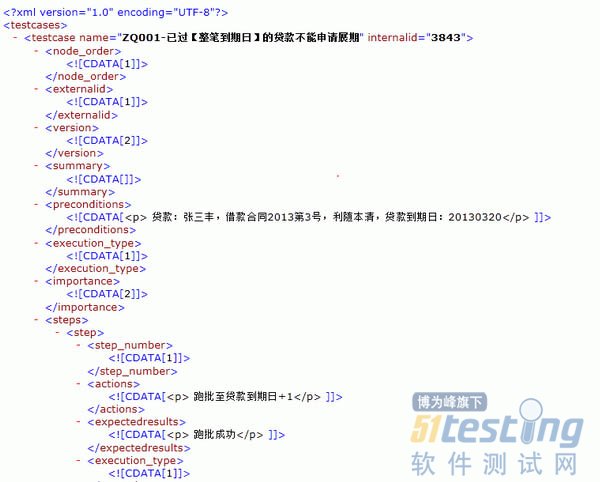目前测试团队要在Testlink写用例,但为了方便呈现还要同时一份excel用例。如果写两份,工作量就太大了,Testlink虽然有导出功能,但是只能导出xml形式,因此把xml形式转换为excel的艰巨任务就交给我啦!
下图是其中一个用例集导出的示范用例截图:
说实话,这个格式比较蛋疼,用python里的Elementtree来解析。关于数据存储格式,想到了每个testcase用字典dic_temp来存,把需要写入excel的项提取出来,由于每个case可能包括很多step,因此每个step的键代表步骤编号,值的话是一个列表list_temp,包括具体步骤和预期结果。
#coding=utf-8 from xml.etree import ElementTree from win32com.client import Dispatch import win32com.client import os class easy_excel: def __init__(self,filename=None): self.xlApp=win32com.client.Dispatch('Excel.Application') if filename: self.filename=os.getcwd()+"\\"+filename print self.filename self.xlBook=self.xlApp.Workbooks.Open(self.filename) else: self.xlBook=self.xlApp.Workbooks.Open(filename) self.filename='' def save(self,newfilename=None): if newfilename: self.filename=newfilename self.xlBook.SaveAs(newfilename) else: self.xlBook.Save() def close(self): self.xlBook.Close(SaveChanges=0) def getCell(self,sheet,row,col): sht=self.xlBook.Worksheets(sheet) return sht.Cell(row,col).Value def setCell(self,sheet,row,col,value): sht=self.xlBook.Worksheets(sheet) sht.Cells(row,col).Value=value sht.Cells(row,col).HorizontalAlignment=3 sht.Rows(row).WrapText=True def mergeCells(self,sheet,row1,col1,row2,col2): sht=self.xlBook.Worksheets(sheet) sht.Range(sht.Cells(row1,col1),sht.Cells(row2,col2)).Merge() def setBorder(self,sheet,row,col): sht=self.xlBook.Worksheets(sheet) sht.Cells(row,col).Borders.LineStyle=1 def set_col_width(self,sheet): sht=self.xlBook.Worksheets(sheet) sht.Columns("D:F").ColumnWidth=30 xls=easy_excel('test.xlsx') xls.setCell('Sheet1',2,2,u"编号") xls.setCell('Sheet1',2,3,u"优先级") xls.setCell('Sheet1',2,4,u"操作步骤") xls.setCell('Sheet1',2,5,u"预期结果") xls.setCell('Sheet1',2,6,u"实际结果") xls.set_col_width('Sheet1') dic_temp={} root=ElementTree.parse("./test.xml") lst_node=root.getiterator("testcase") num=len(lst_node) row_flag=3 step_num=0 for case in range(0,num): steps=lst_node[case].find("steps") step_num=len(steps) keywords=lst_node[case].find("keywords") if keywords is not None: dic_temp['keyword']=keywords[0].attrib["name"] else: dic_temp['keyword']=0 for step in steps: list_temp=[] list_temp.append(step[1].text) list_temp.append(step[2].text) dic_temp[step[0].text]=list_temp row_start=row_flag xls.setCell('Sheet1',row_flag,2,case+1) xls.setCell('Sheet1',row_flag,3,dic_temp['keyword']) for j in range(1,step_num+1): xls.setCell('Sheet1',row_flag,4,dic_temp[str(j)][0]) xls.setCell('Sheet1',row_flag,5,dic_temp[str(j)][1]) row_flag+=1 xls.mergeCells('Sheet1',row_start,3,row_flag-1,3) xls.mergeCells('Sheet1',row_start,2,row_flag-1,2) for row in range(2,row_flag): for col in range(2,7): xls.setBorder('Sheet1',row,col) xls.save() xls.close() print 'success!' raw_input("Press any key to continue...") |
写入excel用了win32com,使用它前提是电脑里要有excel软件,网上虽然有教程但是不是很全,设置单元格格式我就试了很久,个人对win32接口不熟,后来发现搜一搜vb操作excel的方法然后依葫芦画瓢,实现了设置单元格格式以及合并单元格。下图是实际效果:
<p></p>之类的标志是由于导出xml时没做处理,这个可以通过字符串处理的,在此就不赘述了。源码都在附件里,需要自己新建空的test.xlsx。

















